“Thank you God that I live in the kind of country in which people THAT evil, hated it THAT much.”
Feel free to take a knee as you say it.

I’ve been meaning to throw this out there for my fellow sci-fi nerds of a certain age who, like me:
Trust me, all dramas have a political viewpoint and an agenda. We storytellers are always either teaching or preaching.
The original Star Trek series was optimistic, idealistic and infused with a confidence that the guiding principles of Western Civilization, although flawed in execution, were unambiguously good.
How the political philosophy of Star Trek evolved (or actually devolved) over the last 50 years was the subject of a long but fascinating essay by Timothy Sandefur in an issue of the Claremont Review of Books last year, titled “The Politics of Star Trek.”
As the insightful piece pointed out, these changes in underlying ideology track perfectly with the U.S. dominant culture’s descent into Postmodern self-hatred and relativism. (Today, the only thing that can safely be condemned as immoral is moral certitude.)
The original network run of the original Star Trek series unfolded when I was ages six to nine. I was aware of the series but it aired past my bedtime.
I do dimly recall, however, being roughly six or seven and working with a friend to convert a discarded cardboard refrigerator box into our own personal Starship Enterprise, complete with NCC-1701 scrawled on the side with crayon. It was subsequently converted, through some clever feats of retrofitting engineering, into a Batmobile.
Even so, like most fans of my generation, I became a devoted follower only after the series entered syndication and became ubiquitous in reruns for decades.
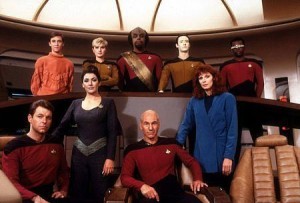 In 1987 Star Trek: The Next Generation revived and reinvigorated the franchise. That was the year I got marred and my new bride and I faithfully watched the new series each week and became invested in the characters.
In 1987 Star Trek: The Next Generation revived and reinvigorated the franchise. That was the year I got marred and my new bride and I faithfully watched the new series each week and became invested in the characters.
Even so, the distinct shift in worldview within the franchise and its spinoffs stuck out to me from the beginning. Sandefur’s essay explores this shift in fascinating detail.
 The latest reboot of the franchise, crafted by master scifi-fantasy storyteller J.J. Abrams, has once again remade the moral framework within which the familiar characters think and act.
The latest reboot of the franchise, crafted by master scifi-fantasy storyteller J.J. Abrams, has once again remade the moral framework within which the familiar characters think and act.
Referring to Abram’s second Star Trek film, Into Darkness, a reinterpretation of the movie Star Trek II: The Wrath of Khan, Sanderfur notes, “By the time Khan reappears under Abrams’s direction, the fixed moral stars by which the franchise once steered have been almost entirely obscured . . . Having lost their principles, the show’s heroes cannot really explain, or understand, what differentiates them from their enemies, and so are rendered vulnerable to the very forces they once opposed.”
This clearly isn’t for everyone. But if you have consumed all the various iterations of Star Trek through the decades and enjoy smart discussions of big ideas (Hi Ted! Hi Jed!), then you will find this essay well worth your time.

A few days ago I called it the biggest under-reported news story of 2015.
I was referring to the damning series of stunning undercover videos exposing Planned Parenthood as a house of abortion horrors and as a key supplier/source for research labs eager to obtain intact baby parts.
Since then, the story has taken an Orwellian turn. First this:
Grand jury in Texas indicts activists behind Planned Parenthood videos.
How could this be? Perhaps this can explain the inexplicable:
Planned Parenthood Board Member Works in Office of D.A. Who Indicted David Daleiden
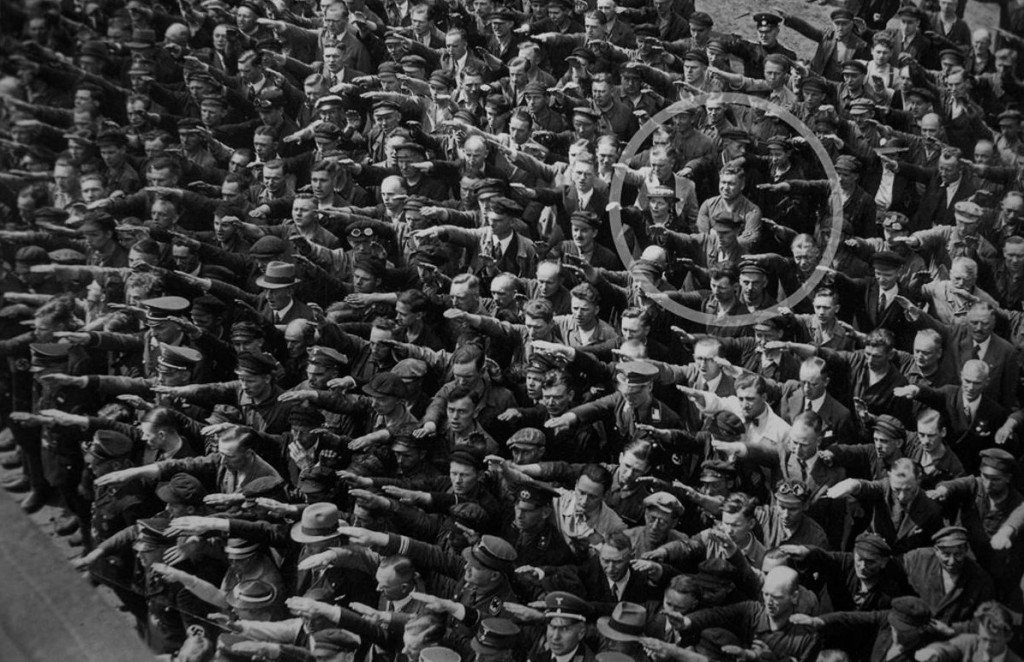
Being a Jesus Follower in a pagan culture means having the courage to be this guy (circled) every day.
Before I just let it go and move on, I thought I’d point out one additional annoying, yea, even galling aspect of the way the writers of Mad Men chose to rescue Don Draper from his eight-year-long free-fall of drink, deception, and debauchery. That is, to have him stagger into a touchy-feely retreat center built around a blend of Eastern mysticism and hippie humanism.
Here’s why that cheeses me off.
As I mentioned in the previous dissertation post, the overarching premise of the entire Mad Men series is that women were treated horribly by Neanderthal men in the years before the feminist movement. But here’s the thing.
The cultures built wholly on Eastern Mysticism—Hindu, Buddhist, Confucian, and Taoist religion—are some of the worst places on Earth to be a woman.
India, for example, is the headwaters of the river of hippie New Age gobbledy-goop that started flowing into our culture like the nasty Ganges in the late ’60s. Thanks Beatles.
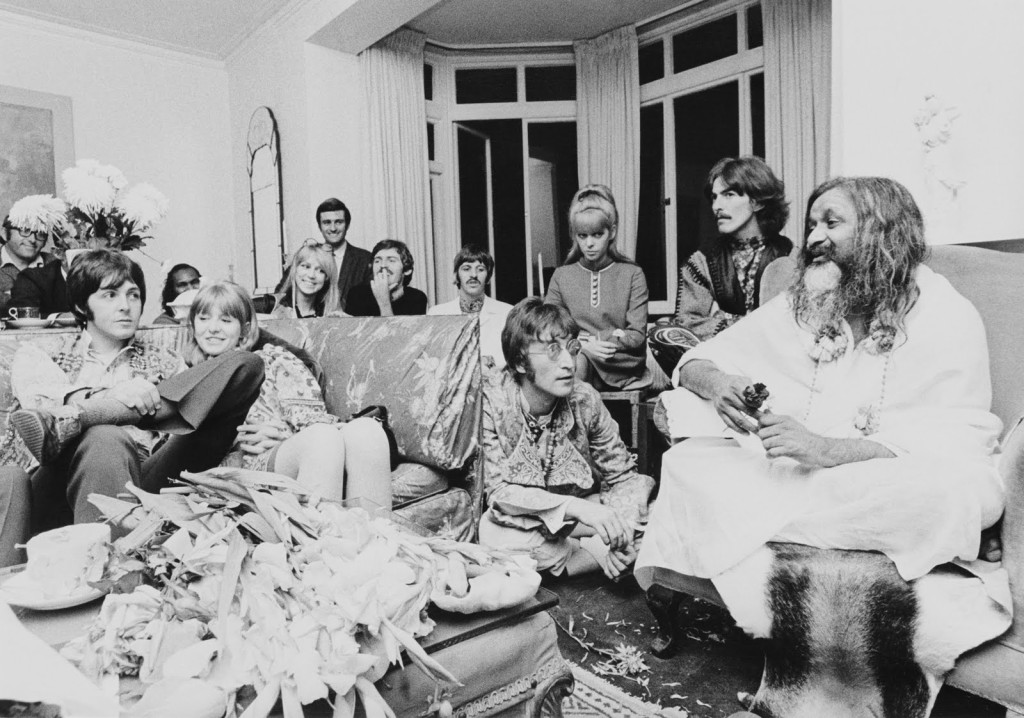
Look at John—hanging on every word of the Maharishi. George has already chugged the Kool-Aid. Paul knows it’s B.S. but he’s here for the weed. Ringo wishes he was somewhere else. Anywhere else.
I currently work with or support about a half-dozen ministries that are working in India—striving mightily to make it a little less of a hellish place to be a female. Same goes for Nepal and Tibet. And China? . . .
Can you point to a single solitary woman in China with any meaningful power or authority? In government or business? Just one?
 The only places on the planet in which it is worse for women than societies built upon Eastern mysticism are Islamic cultures. The animistic societies of Africa aren’t a picnic for females either.
The only places on the planet in which it is worse for women than societies built upon Eastern mysticism are Islamic cultures. The animistic societies of Africa aren’t a picnic for females either.
In fact, across the globe, life is best for women where Christianity has had the largest impact on the culture. The least Christian places are the most oppressive for girls and women.
The clear and indisputable testimony of History is that wherever the Gospel of Jesus Christ has taken root and become a pervasive influence in the creation of the culture, the lot of women has radically improved. In societies built upon Christian presuppositions—such as those in Europe, North America, and Latin America—women enjoy the most equality and highest status. This is the case even when the vast majority of the population has reverted to paganism (Hi there, Europe!)
This is no accident or coincidence.
One of the many effects of the radical, transformative revolution Jesus unleashed; and that has been spreading from East to West across the planet; is the elevation of women to a place of equality with men. And it does so without destroying the God-given distinctives and differences between the sexes.
As I mentioned, in any given month I do work for about a half-dozen organizations that are working to ameliorate a little of the suffering experienced by women and girls in India and the Far East. The needs are overwhelming precisely because Eastern religions spawn cultures that view women as livestock.
Which brings us back to the Mad Men finale . . . This is what makes free-falling Don Draper’s rescue in the arms of Eastern mysticism so . . . well, maddening.
As I noted in my previous post, the series was essentially about the oppression of women. Clearly, the writers, like most post-Christian Americans, have no understanding that if America were built upon the presuppositions of Eastern mysticism rather than those of Christianity, the country would be just another third-world hell-hole for women and girls.
In one of the final few episodes of Mad Men, an angry, unpleasant character shouts at Don that he needs to turn to Jesus.
Of course, that was actually good advice. In fact, it’s good advice for any society that cares about the rights and well-being of women and girls.
The series Mad Men ended the other night after a celebrated eight-year, seven-season run. The show was consistently brilliant in many respects. Amazingly executed, written and performed. But I was a little slow on the uptake where the series was concerned—in more ways than one.
For one thing, I didn’t start watching until midway through the second season. I was hearing lots of buzz so I checked it out, and was immediately drawn in on two fronts. The first was the show’s meticulous . . . make that maniacal . . . recreation of the early ’60s in every detail. I was born in 1959, so my earliest memories are of that era.
Long-time readers will know that I have a soft spot for Mid-Century ephemera and design. (A glance at all the headers from my old blog will confirm this.) (As will the vintage 1964 Omega Seamaster watch I’m wearing as I type these words.)
So at first I enjoyed watching just to bathe in details of each set. For me, and many other loyal viewers, nostalgia was a big attraction. Behold . . . Mid-Century Modern awesomness . . .
The second attraction for me was the window the show offered into the inner workings of a NYC ad agency. As a child, my favorite episodes of Bewitched were the ones that showed Darren Stevens in his role as an ad man at the firm of McMann & Tate. Anytime an episode featured Darren working on a new campaign or trying to come up with a new slogan, I was fascinated.
In fact, I recall thinking that Darren Stevens’ job was precisely what I wanted to do when I grew up. And in a strange way, that’s what happened.
It was only after watching Mad Men for a few seasons and then going back to watch the series from the very first episode that the worldview and agenda of the show—created and guided by Michael Weiner—became abundantly clear to me. (As I mentioned, I was a little slow to catch on.)
A simplified summation of the show’s theme and message is this:
Or to be more precise, “Straight, white men are pigs—at least they all were back in the day . . . before the noble cultural revolutions of the ’60 overturned the oppressive order and put us on the path to cultural enlightenment.”
That’s the pervasive, overarching, unfolding narrative of Mad Men. And all one really has to do to see this is the case is merely watch the very first and last episodes of the series back to back.
The pilot is set in in March of 1960. The events of the final episode occur in November of 1970. They bookend a decade of extraordinary cultural, moral and technological change.
 In the pilot episode, Don Draper is introduced to us as a hard-drinking, chain-smoking, philandering, anti-Semitic, arrogant cad.
In the pilot episode, Don Draper is introduced to us as a hard-drinking, chain-smoking, philandering, anti-Semitic, arrogant cad.
Roger Sterling: Hey have we hired any Jews here?
Don Draper: Not on my watch.
But we soon discover Don is actually one of the more sympathetic men in Weiner’s caricature world. Indeed, every other male we encounter in this fictional universe (with two significant exceptions) are the most horrible and horrifying human beings you’ve ever observed.
Every single scene of the first episode is a freak show of misogyny, racism, entitlement, crudity, rude-ity, and cringe-inducing frat-boy boorishness.
Every woman in the pilot is always and only running a harrowing gauntlet of sexual harassment punctuated by insulting condescension. Some, like the va-va-voomy head secretary Joan, have learned to enjoy the attention. But most just try to put on a brave face and periodically retreat to the bathroom to sob.
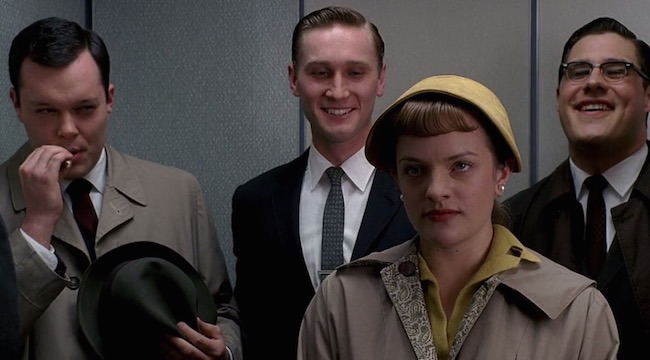 I mentioned there were two exceptions to the “men are monsters” theme of the first episode (and indeed the entire series.) They were the closeted, repressed homosexual art director, Salvatore; and the frustrated novelist copywriter, Paul—a marxist intellectual (who in the first few episodes seems to be the only white person on earth who can actually see the black elevator operator.)
I mentioned there were two exceptions to the “men are monsters” theme of the first episode (and indeed the entire series.) They were the closeted, repressed homosexual art director, Salvatore; and the frustrated novelist copywriter, Paul—a marxist intellectual (who in the first few episodes seems to be the only white person on earth who can actually see the black elevator operator.)
Other than these, there are no male characters with even a shred of decency—much less nobility. None. It’s bad husbands, bad fathers and bad bosses as far as the eye can see.
In other words, Matthew Weiner’s Mad Men was viciously, relentlessly anti-male.
Validating Liberal Mythology: Redeeming the Sick ’60s
 Conservatives tend to believe that our nation lost it’s way in the 1960s. That the drug culture; the sexual revolution; the rejection of traditional sex roles; the abandonment of marriage and family as the organizing paradigm of society; and the embrace of Marxist-Socialist premises about how the world works economically; set our nation on a disastrous course.
Conservatives tend to believe that our nation lost it’s way in the 1960s. That the drug culture; the sexual revolution; the rejection of traditional sex roles; the abandonment of marriage and family as the organizing paradigm of society; and the embrace of Marxist-Socialist premises about how the world works economically; set our nation on a disastrous course.
One from which we’ve never recovered.
Liberals like to believe the opposite–but point almost exclusively to the Civil Rights Movement to make their case. The argument over the 60s usually goes something like this:
Conservative: “Fatherless-ness in this country is a heartbreaking tragedy—creating widespread poverty, crime and imprisonment rates. Back in the 50s most kids got to grow up on a two-parent family and our society was much better for it.”
Liberal: “Oh, so you want to go back to the ‘good old days’ of separate water fountains for blacks and whites, eh, Hitler? You probably have a Klan hood hidden in your sock drawer.”
Conservative: “Um, no. It’s just that a lot of the key supports under-girding our civilization were deliberately knocked out in the 60s.”
Liberal: “You mean like the Jim Crow laws? Why do you hate black people?”
Conservative: “That’s not at all what I’m . . . oh, nevermind.”
It’s true that conservatives were largely wrong about the civil rights movement, mainly because they couldn’t find a way to separate it from the larger cultural battle taking place over traditional values; or from the Cold War paradigm (the threat of the Soviet driven spread of global Marxist-socialism) that permeated every other aspect of life in the ’60s.
In other words, the civil rights movement was presented to most Americans as only one element in a  larger bundle of societal changes being relentlessly pushed by Progressives. That bundle included rejection of capitalism in favor of Marxist redistribution of wealth and the rejection of the notion of private property.
larger bundle of societal changes being relentlessly pushed by Progressives. That bundle included rejection of capitalism in favor of Marxist redistribution of wealth and the rejection of the notion of private property.
It is no coincidence that Lyndon Johnson’s Civil Rights Act of 1964 and his “War on Poverty” legislation were presented simultaneously and as two halves of a whole.
The former was noble and necessary. The latter was arguably the worst thing to happen to black people since the first Portuguese slave ships showed up off the west coast of Africa.
In retrospect, conservatives were wrong to oppose the first and absolutely correct in opposing the second. Unfortunately, the two were inseparable.
If you read conservative essays from the ’60s you’ll find lots of hand-wringing about whether or not civil rights leaders were being influenced or financed by Soviet front groups. These fears may seem comical now, but the concerns were very real at the time. And, as we learned after the collapse of the Soviet Union made lots of Kremlin records available to researchers—the Soviets were indeed actively encouraging, not to mention financing, a lot of Progressive groups and campus rabble rousers—and had been for decades.
Many of these ended up running the country in the ’90s and beyond . . .
So the dispassionate verdict of history is that conservatives were wrong about the Civil Rights Movement and right about everything else. But liberals don’t like that verdict. So, on to . . .
Validating Liberal Mythology: Redeeming the Dreadful ’60s
In response, Matthew Weiner seems to have written Mad Men as an attempt to redeem the cultural upheavals of late ’60s by painting the world of the early ’60s in the darkest possible shades.
In other words, it’s the typical Progressive argument. That is, the ’60s didn’t really represent a change in behaviors. It just made all the depravity less hypocritical by moving it out in the open.
By Eastern New Age Group Therapy Are Ye Saved
The most disappointing (but given everything I’ve already cited, not all that surprising) aspect of the way the series ended (spoiler alert) is having Don Draper—hitting rock bottom— find peace and enlightenment at a New Age-y group therapy retreat camp on the California coast.
Observers have noted that the place Don lands is surely modeled on a place called the Esalen Institute in Big Sur, California. The place was ground zero for something in the sixties called the “Human Potential Movement.”
In the final episode Don stumbles into the place and ends up in a series of group therapy sessions in which the participants are incessantly asked about their feelings. “How does that make you feel?” has become a jokey cliche associated with quack psychiatry, but in these groups this is taken to absurd levels.
“Carl, how does that make you feel?”
“And John, how do you feel about how that makes him feel?”
And so on.
That’s right. Mad Men ends with America’s most iconic selfish rogue being transformed into a touchy-feely new age sensitive guy through the power of meditation, hugging and hippie love.
Ask my wife . . . As this became clear the first time I viewed the finale, I started yelling at the television:
“Are you serious?! You’ve got to be kidding me!”
I haven’t been as let down by a series finale since LOST wrapped up.
But there was one aspect of the transformations that occurred in the sixties that Weiner & Co. couldn’t conceal—not and still remain true to their fanatical devotion to recreating the period’s look and feel. I’m talking about how hideously ugly everything got as the decade of the sixties progressed.
Plaid Men
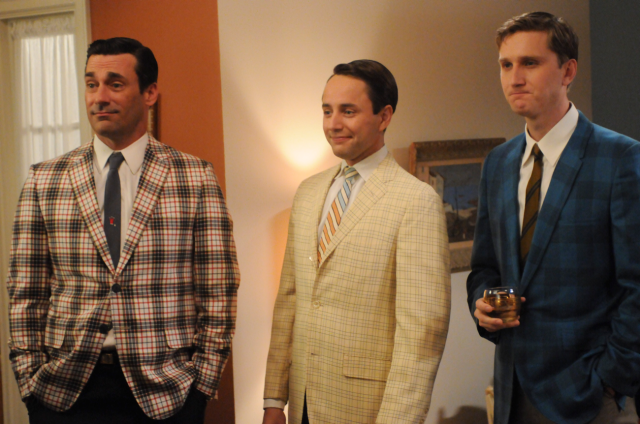 What this series makes massively clear is that in one short decade this culture lost its collective mind where design and aesthetics are concerned. Everything—architecture, clothing, art, typography—went to hell.
What this series makes massively clear is that in one short decade this culture lost its collective mind where design and aesthetics are concerned. Everything—architecture, clothing, art, typography—went to hell.
We started with the clean, classy Mid-Century furnishings that are so prized today. Here’s Roger Sterling’s office in 1960:
Here’s Roger’s office nine years later . . .
In which space would you rather spend your days?
Those two pictures pretty much tell you everything you need to know about the the sixties—the decade the wheels came off.
. . . Shouldn’t you guys have @StevePickett11 and a crew at her house trying to gin up a shame storm? Maybe try to run her out of business? Go all Memories Pizza Indiana on her? Provoke a bomb threat or two?
Confused? Allow me to explain.A troubling line was crossed here in Dallas-Fort Worth—in a lame and ridiculous sort of way—this week. The news department of the local CBS affiliate dispatched a reporter to a local woman’s business to ask her about something she posted on her Facebook page.
No, it wasn’t a bomb threat. Nor did she post the formula for a cancer cure. This woman is not a politician or an entertainer.
Dallas business owner Cheryl Rios found a camera in her face for sharing . . . wait for it . . . her strong lack of enthusiasm for the prospect of a female president.
That’s right. Cheryl prefers that her presidents come with a Y chromosome, an Adam’s apple, and a five-o’clock shadow. And she said so brazenly right there on her personal Facebook page (to her friends, relatives and former high school classmates).
(Now stay with me here. I’m not making this up.) Somewhere in the bowels of the CBS11 Newsroom—a real, honest-to-goodness news department in a major American city—someone thought this was newsworthy. Seriously.
Thus “Emmy-winning journalist” Steve Pickett sallied forth to see what this monstrous freak of nature had to say for herself. And we got this . . .
Now Cheryl obviously agreed to this interview. She could have declined to talk to these nincompoops and she would have been doing them a tremendous favor if she had—because they embarrassed themselves. But they did more than that.
They crossed a line.
You see, the moment news organizations start getting comfortable with making the off-the-cuff social media comments of private citizens fair game for news coverage—coverage which can get national traction on social media and prompt a vicious hate storm, as happened with Memories Pizza in Indiana a couple of weeks ago—then freedom of expression for conservatives and Christians is as good as dead in this country.
That’s why we really can’t allow these media enforcers of political correctness to get away with this kind of thing. If we don’t push back here it will only get worse.
Along these same lines, NationalReview.com’s Ian Tuttle took note and posted this: The Shaming of Cheryl Rios. I recommend it.
Here’s the email address for Channel 11’s news department. [email protected]
Now you’ll have to excuse me. I’m going to head over to my Facebook page and post something wildly reactionary and out-of-step with the spirit of this age.
And hey, CBS11, I’m in the book if you want to chat. I have plenty to say.
This 1,000-word blog post of mine summed up in fewer than 120 characters:
My previous post addressed the endemic and dismaying tendency of many to uncritically accept any piece of information—no matter how ridiculous—if it validates their existing biases. To put it in the Postmodern vernacular . . . Anything that fits your preferred narrative is clearly true and obviously important.
As I’ve already noted, no one is immune, but younger, politically liberal Americans seem to have a terminal case of this disease. Shocking, I know. Who would have ever thought that a generation of badly educated people with little life experience, no historical perspective, and a inflated sense of their own ethical righteousness could be so easily fooled?
This week’s face-palm triggering example comes by way of a couple of fake news articles on the liberal fake news web site. The Daily Currant is sort of like The Onion but without the intelligence, wit or subtlety. The editors clearly hate conservatives but hold an especially intense loathing for Sarah Palin. So this week the DC posted two fake stories designed to give Palin haters a comforting hot oil foot massage:
Soon the social media channels exploded with mockery. Thousands of eye-rolling liberals linked to the articles—clearly believing these were real news stories—and offered their own comments about how stupid Sarah Palin is:





 That’s right, “Magenta.” Sarah Palin is the idiot.
That’s right, “Magenta.” Sarah Palin is the idiot.
This is just a small sampling of the tens of thousands of social media comments earnestly tapped out this week calling Sarah Palin an imbecile and accompanied by links to a fabricated news story on a fake news website. Just marinate in the irony of that for a moment.
As I said in the previous post, the easiest lie to fall for is the one that you need to be true. The Bible calls this deception. And deception is the only option when you’ve been blinded by your own pet narrative.
